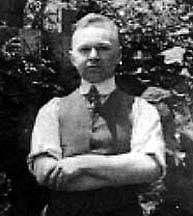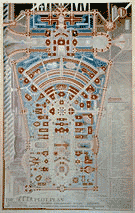
| MAIN BIOGRAPHIES |
|
Nelson Algren |
|
Neal Cassady |
|
Raymond Chandler |
|
Edward Dahlberg |
|
William Browning Spencer |
|
Olaf Stapledon |
|
Alan Turing |
|
Emiliano Zapata |
|
|

A. G. Rizzoli
Biographical Notes
Achilles G. Rizzoliwas born in 1896 in Port Reyes, north of San Francisco, California. His parents,Innocente and Emma, were Swiss Italians who immigrated to the UnitedStates in the 1880's. Innocente was a dairy farmer. Achilles was thefourth of five children.
Moves to Oakland in 1912 to attend the Polytechnic College of Engineering. He takes classes in mechanics, geometry, magnetism and electrical engineering.
A sister becomes pregnant out of wedlock in 1913 and the family splits apart, the mother and sisters moving to Oakland, the father remaining behind in Pt. Reyes.
In 1915, the father Innocente "disappears" with a stolen gun. The event traumatizes Achilles. He later refers to it as a proposed building, "The Dark Horse of the Festival Year".
He is recommended for membership to the San Francisco Architectural Club, where he is able to pursue classes in mechanical drawing and rendering.
In that late 20's and early 30's, he attempts to make a living as a writer, collects 280 rejection notices. Many of the stories deal with a group of architects attempting to realize various utopias.
The family moves around quite a bit until 1933, when Achilles and his mother settle into a small four room house in San Francisco. He makes few friends and remains a lifelong virgin. He will live there, sharing a bedroom with his mother, for the rest of his life.
Begins to produce large pen and ink architectural designs filled with utopian images in 1935. Symbolically represents people that he knows as monumental buildings, many to indicate the metamorphosis these individuals would undergo after death.
Sets up a "gallery" in one of the front rooms of his house, open the first Sunday in August 1935. Calls it the Achilles Tectonic Exhibit Portfolio, the A.T.E.P.. Very few people attend. Those who did were later architecturally honored, although most of them never knew about it.
In 1936, he is hired at an architectural firm as a draftsman. Later that same year, the remains of his father are finally discovered, an apparent suicide.
On12 April 1936, glimpses the genitalia of a young girl as she plays next door. He writes: "Hold everything! How the heart throbbed puzzlingly trying desperately to escape through... the tightening passage known as the throat... at the thought that at the old age of 40 one should finally get a glimpse of the veeaye...." (He had created elaborate and punning terms and acronyms for various themes of his world.)
Draws symbolic representations of huge phallic towers decorated with male and female genitals in "The Primal Glimpse at Forty," charts the formula for the orgasm in "The Bluesea House" and explores his obsession with the neighbor's little girl in:

"The Veeaye/The Oranament"
(The above sketch is heavily in debt to the recently published,
A G Rizzoli: Architect of Magnificent Visionsby Jo Farb Hernandez, John Beardsley, Roger Cardinal, 1997.)
His mother dies in 1937, due to complications of a leg amputation fromdiabetic gangrene. At the funeral, Rizzoli is remembered to have stoodby the casket trying to open his mother's eyes.
For the rest of his life, he lives an intensely ascetic life,maintaining the house exactly as his mother had left it, sleeping in acot at the foot of her bed, eating the exact same meals.
Plunges ever deeper into his life's work: the architectural expressionof his utopia, the Y.T.T.E., Yield To Total Elation. Inspired by the 1915 Panama-Pacific Exposition, the Golden Gate Bridge and Gothic Cathedral design, the Y.T.T.E. develops over the years into an island complex with over 80 buildings ( "The Toure of Phallism," "Palace of Relaxation," "The Temple of Dreams") and 20 monumental sculptures of such abstractions as poetry, happiness and peace. The "Acme Sitting Station," A.S.S. was the toilet's designated name. And if you so desired to shake off this mortal coil, there was:
"The Shaft of Ascension"
where you would be pleasantly and painlessly euthanized.
He stops the public A.T.E.P. exhibitions after 1940. However, he continues to celebrate the annual exhibition privately for the rest of his life.
After 1945, he experiences an increasing number of visions, attempts to realize these graphically, considers them to be a third testament to the Bible. Personifies, and is inspired by, Miss Architecture Made To Entertain, Miss A.M.T.E., who is something of a virginal consort of Jesus Christ.
Over the years, continues working on A.C.E., AMTE's Celestial Extravaganza, frustrated by his inability to capture his visions, complaining about how easily he loses track of time. His talents on paper show no diminishment of ability.
Suffers a stroke on 23 February 1977 while walking down the street. His house is cleaned out, many of the items in it are auctioned off to support his last years of life in a nursing home.
Died on 18 November 1981. He was buried, in a manner he had specified and paid for years before, next to his mother in San Francisco.
On the 12 July 1990, a woman shows a collection of Rizzoli's drawings to a gallery owner, who immediately recognizes them as works of original genius. She tracks down one of Rizzoli's nephews, who had lots of his "uncle's stuff" stored out in his garage. A. G. Rizzoli is "discovered."
Rizzoli's work was featured at the American Folk Art Museumas part of The Outsider Art Fair.
A. G. Rizzoli: Architect of Magnificent Visions
Installation designed by Tod Williams Bille Tsien and Associates
Saturday, January 17, 1998 - Sunday, March 8, 1998, 2 Lincoln Square, New York, New York 10023, United States.
Quotes
-
One more day, one step closer to the grave.
-
We sincerely believe we have delineated the most remarkable and singular impression ever possible of expressing in terms of decorative architecture unique to extremes hardly possible of visualization unless one has actually experienced the oddly intrinsic throbbing ordeal, thereupon we feel we have produced the most picturesque and precious piece of, or at least essayed the initial move in what may be considered a new movement in the history of art.
-
Too so soon four odd years mere weeks it seems/ Entreating limping murmurs ruling gloom./ Be there sleep-moments' times of longings, dreams/ Oft of your Dear Self in your treasured room.
Subcultural Relevance
The outwardly sad lonely life, moving through the deep and dreary rut of the daily routine, existing outside of the gaze of the other, immune because invisible; but inwardly rich to a degree almost threatening. Looking into Rizzoli's works, one is forced to reckon with an imagination that overwhelms with its monumental reach. And the question always is why he wasn't known during his life? Perhaps there is a certain tragedy here. But not for Rizzoli. It is difficult to imagine that he might have wished his life other than it was. The tragedy is that this society we serve and preserve has no place for individual like Rizzoli. What was there to commodify? Any attempt would have most certainly ruined him. The relevance of Rizzoli is twofold: primarily for the work as an excellent example of visionary art; and then, as an indicator of what place there is in this society for the visionary artist.
Other Links
-
Hakim Bey's Radio Sermonette on ImmediatismWhich Locates the Relevance Or Art in Society
-
OutsiderArt.org- links directly to one of 2 pages with images that are housed on the site. Click next to see the other Rizzoli work.
-
Yield To Total Elation: biographical documentary of A.G. Rizzoli by New Day Films.
-
San Francisco Museum of Modern Art A. G. Rizzoli Exhibition Page
Major Works
-
A G Rizzoli: Architect of Magnificent Visionsby Jo Farb Hernandez, John Beardsley, Roger Cardinal, 1997
-
Kooks: A Guide To the Outer Limits of Human Belief: Donna J. Kossy
Author: Bonesy Jones